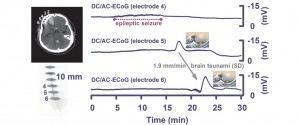The Problem: Brain Tsunamis

This figure illustrates the recording of spreading depolarizations in the human brain. Electrodes are placed on the surface of the brain after neurosurgical treatment of severe brain injury. Here, a large wave is recorded at electrode 5 and then spreads to electrode 6, moving through the brain at 2 mm/min. The waves are about 30 times the amplitude of normal brain activity and thus resemble ‘tsunamis’. The relatively small scale of an epileptic seizure on electrode 4 can be seen for comparison.
In 1944, the Brazilian physiologist Aristides Leão made an unexpected discovery during his dissertation research at Harvard University. After intensely stimulating the brain’s cerebral cortex, he observed a propagating wave of suppressed cortical function which he termed “spreading depression.” Later work showed that these waves are massive short-circuits of the batteries that drive the brain’s electrical activity. Since the normal polarity of these batteries is lost, these waves are called spreading de-polarizations. During a spreading depolarization, brain cells swell, cease electrical function, and enter a twilight state of near-death. Because of the profound perturbation, spreading depolarizations are nick-named brain tsunamis.
Leão subsequently observed that similar changes occur after blocking blood flow to the brain, thus making the first connection between spreading depolarizations and brain injury. In the 1970’s, researchers began to appreciate that these waves occur spontaneously in the brain after acute injury. By the 1990’s, it was proven in animals that brain tsunamis cause the progressive death of brain tissue and expansion of injuries. Several studies showed that the number and duration of spreading depolarizations that occurred after stroke was a critical determinant of the size of the brain lesion that developed. However, convincing evidence that spreading depolarizations were relevant to human disease was still lacking. See History for how the story continues today.
Video: A recording of brain electrical activity, played back 44x normal rate, in a patient who suffered a traumatic head injury. The crackling sound is the normal activity of brain cells; the periods of silence are short-circuits of electrical activity caused by brain tsunamis, waves of depolarization that spread across injured areas of the brain, causing a local loss of function. The brain’s electrical activity recovers, but with each brain tsunami, damage to cells may worsen.
